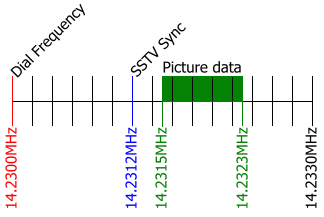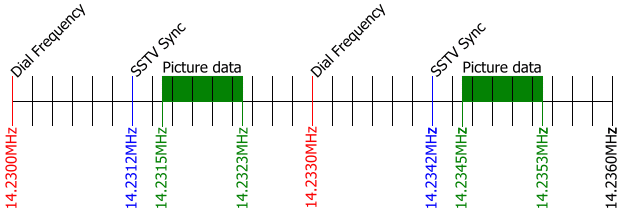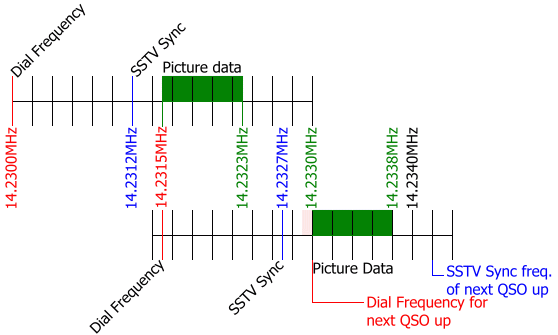

CLOSE SPACING OF SSTV SIGNALS


 To
the right is a diagram of how two SSTV signals one transmitted on
14.230MHz and the other on 14.2315MHz would be situated on the band.
The sync signal of the 14.2315 QSO appears
2.7kHz (0.0027MHz) above the dial frequency of the 14.230 transmission
- i.e. on the upper edge of the 14.230 QSO's SSB receive bandwidth
(14.230MHz + 2.7kHz = 14.2327MHz). Another SSTV QSO can then take place
with a dial frequency of 14.233. If only SSTV is
being transmitted and stations in adjacent QSOs do not cause splatter
then this scheme works. I would go as far to say that even
the
short "73" type phone messages would cause little harm to adjacent
QSOs. 1.5kHz spacing means that approx. 73% of the spectrum
carries useful SSTV data.
To
the right is a diagram of how two SSTV signals one transmitted on
14.230MHz and the other on 14.2315MHz would be situated on the band.
The sync signal of the 14.2315 QSO appears
2.7kHz (0.0027MHz) above the dial frequency of the 14.230 transmission
- i.e. on the upper edge of the 14.230 QSO's SSB receive bandwidth
(14.230MHz + 2.7kHz = 14.2327MHz). Another SSTV QSO can then take place
with a dial frequency of 14.233. If only SSTV is
being transmitted and stations in adjacent QSOs do not cause splatter
then this scheme works. I would go as far to say that even
the
short "73" type phone messages would cause little harm to adjacent
QSOs. 1.5kHz spacing means that approx. 73% of the spectrum
carries useful SSTV data. QSOs
taking place - four analogue SSTV and one DRM. The first SSTV QSO
has a dial frequency of 14.230MHz. Using 1.5kHz spacing the next
SSTV QSO would have a dial frequency of 14.2315MHz but that would
interfere with the DRM QSO on 14.233MHz. An SSTV QSO on 14.233MHz
would also interfere with DRM. If the next 1.5kHz frequency,
14.2345MHz is used then the SSTV sync. signal would be on the upper
edge of the DRM signal so 14.2346MHz is better to use as a dial
frequency in this situation to nudge the sync. signal just above the
DRM signal. The next SSTV QSO has a dial frequency of 14.236MHz
which is normal for 1.5kHz (and 3kHz) spacing, and the fourth SSTV QSO
(picture data and sync. signal not shown) has a dial frequency of
14.2375MHz which is also normal. So moving the second SSTV QSO up
100Hz makes no difference to where each QSO sits on the band but saves
the DRM on 14.233MHz and the SSTV a lot of QRM. ( As mentioned
already, SSTV QSOs can easily occur on frequencies above and below
those shown in the above diagram but have been omitted for clarity).
QSOs
taking place - four analogue SSTV and one DRM. The first SSTV QSO
has a dial frequency of 14.230MHz. Using 1.5kHz spacing the next
SSTV QSO would have a dial frequency of 14.2315MHz but that would
interfere with the DRM QSO on 14.233MHz. An SSTV QSO on 14.233MHz
would also interfere with DRM. If the next 1.5kHz frequency,
14.2345MHz is used then the SSTV sync. signal would be on the upper
edge of the DRM signal so 14.2346MHz is better to use as a dial
frequency in this situation to nudge the sync. signal just above the
DRM signal. The next SSTV QSO has a dial frequency of 14.236MHz
which is normal for 1.5kHz (and 3kHz) spacing, and the fourth SSTV QSO
(picture data and sync. signal not shown) has a dial frequency of
14.2375MHz which is also normal. So moving the second SSTV QSO up
100Hz makes no difference to where each QSO sits on the band but saves
the DRM on 14.233MHz and the SSTV a lot of QRM. ( As mentioned
already, SSTV QSOs can easily occur on frequencies above and below
those shown in the above diagram but have been omitted for clarity).